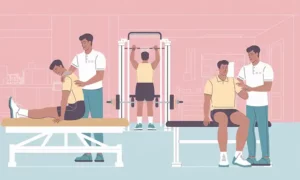Back pain is one of the most common issues that people experience. It can affect your daily life and can lead to debilitating symptoms.
While there is no cure for back pain, Physiotherapy narellan can help patients get to the root of their problem and learn how to manage their symptoms. This helps them avoid relapses of pain and disability.
Addressing Lower Back Pain through NDIS Physiotherapy: Assessment and Treatment Options
Weakness in the muscles around the spine is a common cause of lower back pain, which can be treated through NDIS physiotherapy. A thorough assessment of the structures causing the pain is provided by the physiotherapist, who recommends treatments to resolve the problem. Improving flexibility and strength with the physiotherapist’s help can reduce the chances of back pain recurring. Factors such as aging, pregnancy, weight gain, a lack of exercise, heavy lifting or pulling, or an underlying medical condition can also contribute to back pain. With several treatment options available, the physiotherapist determines when to apply each technique. Early intervention with a physiotherapist is crucial in preventing further damage to the body and receiving prompt treatment. If you have back pain, you may be wondering how to get it under control and get yourself moving again. This is where the help of physiotherapy comes in.
When you see a physiotherapist, they’ll do a detailed medical history and physical examination to look at how your spine works. They’ll also ask you about your lifestyle and work environment.
The physiotherapist will then provide a detailed assessment and a treatment plan to meet your needs. Your physiotherapist will then create a treatment plan that is tailored to your needs. It will take into account the cause of your back pain, how long you have had it, and how severe it is.
Your treatment plan might include stretches, exercises, and manipulations of your muscles and joints. These will help you stop suffering from lower back pain by improving your strength, movement, and control.
Your physiotherapist may recommend exercises to strengthen the core muscles in your abdomen, back, and pelvic area depending on the cause of your lower-back pain. While these exercises can be helpful, they are not always the best option for the long-term.
Your physiotherapist may also recommend aerobic exercise as a method to reduce lower back pain. They’ll advise you to start with low-impact exercises and increase the intensity as your body adjusts. They’ll also encourage you to stay active and limber as much as possible, without overdoing it.
What is Physiotherapy for Back Pain?
Physiotherapy can be used to reduce back pain and improve mobility. It’s also used to aid recovery after injury or surgery.
During a physiotherapy session, your therapist will take an assessment of your symptoms and determine the best way to treat them. This could include hands-on manual therapy such as soft tissue massage and joint mobilization. They may also provide exercises to improve spinal mobility and core stability.
Your physiotherapist will also evaluate your posture and recommend ways to reduce or avoid further injuries. This includes learning how to move in a way that doesn’t cause back pain, such as when you do work or play sports.
Many people find that regular exercise helps them to manage back pain. This can include strengthening exercises for the core muscles that support your back, such as those around your stomach and pelvis.
These exercises are often combined with stretches, which are designed to relax your muscles and improve flexibility. They’re also a great way to relieve spasms caused by poor posture or nerve irritation.
It is important to seek immediate medical attention if you are suffering from lower back pain. This can make a big difference in your quality of life, and allow you to return to normal activities faster.
Your physiotherapist may recommend multiple sessions of treatment. The number of sessions you need will depend on how severe your back pain is and how quickly you respond to treatment.
How does physiotherapy work for lower back pain?
Physiotherapy is a treatment that relieves lower back pain by strengthening the muscles, joints, ligaments and nerves. This helps to reduce inflammation, improve movement and flexibility and relieve nerve irritation and pain.
Your therapist will evaluate your health, lifestyle, and medical conditions to determine the best treatment for you. Your therapist may use manual techniques (hands-on) or exercise programs to treat your condition.
Physical therapy can also be used to treat other conditions, such as arthritis and sprains. It can be a great way for people to recover from injuries or surgeries.
It can also be a useful tool to manage chronic pain, such as headaches or back pain. Physiotherapy has been shown to reduce or eliminate the need for pain medications in some patients.
A physiotherapist will often recommend a month-long program of exercises for lower back pain. This is to strengthen the body and reduce the pain. In cases where physiotherapy isn’t successful, they may recommend other treatments up to and including surgery.
Some physiotherapists also use a type of therapy called Prolotherapy to strengthen the ligaments in the lower back and pelvis. Research has found this treatment to be effective in strengthening and stabilizing loose ligaments, which are often a major contributor to low back pain.
Physiotherapy can be an effective tool in managing back pain. However, it is important to talk with your doctor about the condition and get a referral before you see a physiotherapist. Your physiotherapist can give you tips and advice about how to reduce the chance of episodes, improve posture, reduce triggers, and encourage safe exercise that won’t cause more damage or pain.
How can I tell if my back ache is serious?
Back pain is often a sign that something isn’t right with the bones, ligaments, muscles and nerves of the lower back. It can occur at any time and it usually improves over time. You can self-treat by taking anti-inflammatories, cold and heat therapy, or taking anti-inflammatories.
Most back pain is caused by a sprain (a strain) or injury to the muscles in the lower back, but some can be serious if they occur from a medical condition like a herniated disc or sciatica (a trapped nerve). Your pain may be severe if it lasts more than a week, radiates to other areas of your body, or causes other symptoms like fever, numbness, or muscle weakness.
Generally, when you come in to your doctor with back pain, they will do a simple exam, looking at your reflexes and checking for nerve-related symptoms. Dr. Van Dien says this exam is a good way to rule out other possible causes.
Most back pain will disappear within a few weeks, unless you have an injury that requires immediate medical attention. However, if your pain is severe or is getting worse and is affecting your daily activities, it’s time to see a doctor.
Physiotherapy Treatment for Lower Back Pain
Lower back pain is a common problem that affects nearly everyone at some time. It can be mild and go away on its own, or it can become severe and prevent you from living your normal life.
The vast majority of back pain is a mechanical condition, meaning that it is due to strains and sprains caused by twisting, lifting or overexertion, and these tend to respond well to physiotherapy. Sometimes, however, low back discomfort can be a sign that there is an underlying medical condition.
In these cases, a physiotherapist can identify the underlying cause and work to resolve it. They will devise a customized stretching and exercise program to reduce pain and strengthen your back muscles.
A physical therapist will also use manipulation and mobilization techniques to improve the mobility of joints and soft tissues. These treatments can be very beneficial, especially in the early stages.
It’s important to remember that there are many different factors that can contribute to your back pain and this is why it’s so important to consult with a physical therapist as soon as possible when you start to notice symptoms.
When you visit a physiotherapist, you’ll be given a tailored program that includes stretching exercises, strengthening exercises, manual therapy and other forms of treatment. These techniques will improve your mobility and relieve pain so that you can return to work as quickly as possible.
Frequently Asked Questions on Physiotherapy for Lower Back Pain: The Ultimate Guide
Q: What is physiotherapy for back pain?
A: Physiotherapy is a treatment that helps relieve lower back pain by strengthening the muscles, joints, ligaments, and nerves. It aims to reduce inflammation, improve movement and flexibility, and relieve nerve irritation and pain. A physiotherapist will assess your symptoms, evaluate your health and lifestyle, and determine the best course of treatment for you.
Q: What will happen during a physiotherapy session for lower back pain?
A: During a session, your physiotherapist will assess your symptoms and determine the best way to treat them. This could include hands-on manual therapy such as soft tissue massage and joint mobilization, as well as exercises to improve spinal mobility and core stability. They may also evaluate your posture and recommend ways to reduce or avoid further injuries.
Q: How does physiotherapy work for lower back pain?
A: Physiotherapy works by strengthening the muscles, joints, ligaments, and nerves in the lower back. This helps to reduce inflammation, improve movement and flexibility, and relieve nerve irritation and pain. A physiotherapist will assess your health, lifestyle, and medical conditions to determine the best treatment for you.
Q: Can physiotherapy help with chronic back pain?
A: Yes, physiotherapy can be a useful tool to manage chronic back pain. It has been shown to reduce or eliminate the need for pain medications in some patients. A physiotherapist will recommend a month-long program of exercises to strengthen the body and reduce the pain.
Q: What types of exercises may be recommended during physiotherapy for lower back pain?
A: Your physiotherapist may recommend exercises to strengthen the core muscles in your abdomen, back, and pelvic area, as well as aerobic exercise to reduce lower back pain. They may also recommend stretches to improve flexibility and relieve muscle spasms. Your treatment plan will be tailored to your individual needs and will take into account the cause of your back pain, how long you have had it, and how severe it is.
Q: How many physiotherapy sessions will I need for lower back pain?
A: The number of sessions you need will depend on how severe your back pain is and how quickly you respond to treatment. Your physiotherapist may recommend multiple sessions, and the frequency and length of each session will be determined based on your individual needs.
Q: What happens if physiotherapy isn’t successful in treating my lower back pain?
A: In cases where physiotherapy isn’t successful, your physiotherapist may recommend other treatments, such as Prolotherapy or surgery. It is important to talk to your doctor about your condition and options for treatment.





































